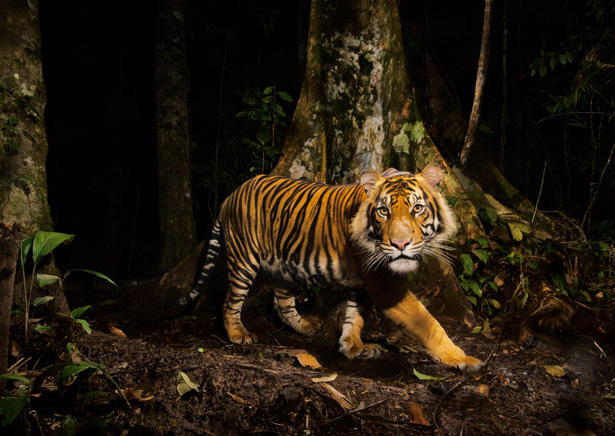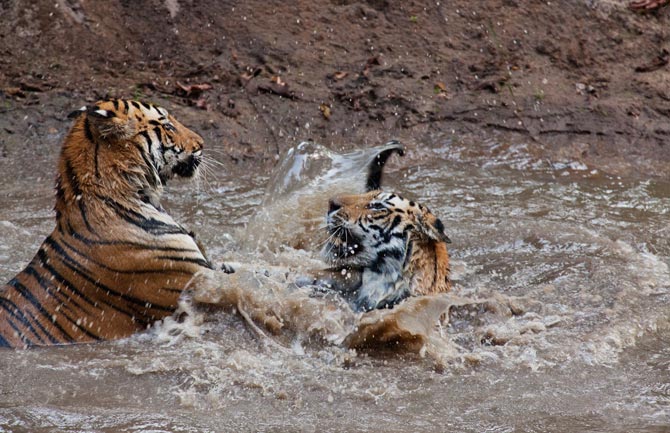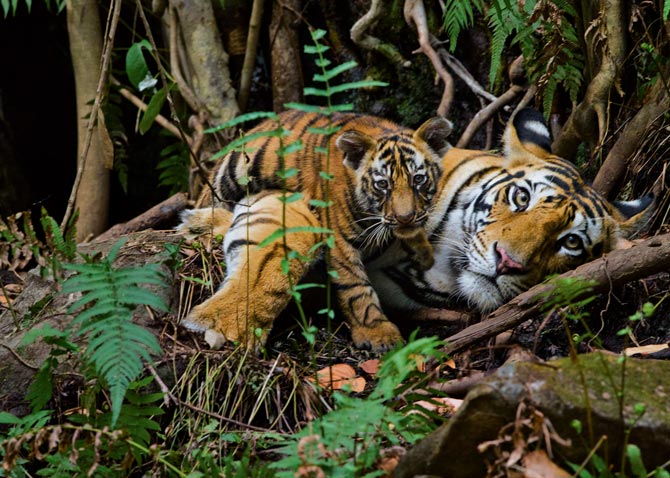The tiger, Panthera tigris, is largest of all the big cats.
A tiger’s roar can be heard as far as 3 kilometers away.
Tigers are endangered – there are less than 4,000 of them remaining in Asia.
トラ、学術名Panthera tigersは大型の猫科の中で一番大きいです。
トラのうなり声は3キロメートル離れた地点でも聞こえます。
トラはアジアに4,000頭以下しか残っていない、絶滅危惧種です。

According to a National Geographic article, in the early 1980’s it was estimated that nearly 8,000 tigers remained in the wild. But now there are less than 4,000!
We are losing tigers because of loss of habitat, increasing human population, poverty (which causes people to poach – illegally hunt animals), failed conservation plans, and the Chinese black market for tiger parts.
Now, because there are so few, seeing tigers in the wild is now mostly a tourist experience—the Bengal tiger is not only India's national animal but also one of the country's largest draws.
ナショナル・ジオグラフィックの記事によると、1980年代初めには8,000頭近いトラが野生で残っていたと推定されていました。しかし今では4,000頭以下です!
生息地の減少、人口の増加、貧困(これが密猟、違法に動物たちを狩る人々を生じさせた)、保護計画に失敗したこと、そして中国のトラの部位の闇市のため、わたし達はトラを失いつつあります。
今ではトラはとても少なく、野生のトラを見ることはほとんど観光客のすることです―ベンガルトラはインドの国の動物であるだけでなく、国の中でもっとも大きな呼び物でもあります。

In the past, Tiger hunting was legal in India until the early 1970s and people could shoot a tiger for “maybe a hundred rupees – a couple of dollars” according to a former game warden.
There used to be a private hunting estate that is now a tiger reserve called Ranthambore.
It is one of 40 tiger reserves in India. Interestingly, Ranthambore is surrounded by the original containing wall of the hunting estate and there are romantic maharaja-era ruins scattered throughout the reserve.
昔、以前の猟区管理人によると、1970年代の初めまでトラ狩はインドでは合法で、人々はおそらく百ルピー―数ドル―のためにトラを撃ちました。
今はランタンボールと呼ばれるトラ保護区は、かつてはプライベートの狩猟所でした。これはインドにある40のトラ保護区のひとつです。
興味深いことに、ランタンボールは狩猟地域を制する最初の壁に囲まれていて、現実離れしたマハラジャ時代の遺跡が保護区のあちらこちらに散らばっています。
One problem with these reserves; however, is that they are like separate islands over the landscape.
Tigers can range over a hundred miles so they often want to leave the reserve to go hunting or to find a mate, but then they enter dangerous areas where they are not as well protected.
So, conservationists want to make corridors that connect the reserves so tigers can safely go from reserve to reserve.
しかしながら、これらの保護区のひとつの問題として、景色の中で別々の島々のようになっていることがあげられます。
トラは100マイル以上を歩き回るので、しばしば狩をしに行ったり、仲間を探す為に保護区を出ようとしますが、そうすると彼らが守られていない危険なエリアに出くわすことになります。
なので自然保護活動家たちはトラが安全に保護区から保護区へ移動することが出来るように保護区同士を繋ぐ回路を作りたいと考えています。
The largest tiger reserve in the world is in northern Myanmar.
It is called Hukawng Valley Wildlife Sanctuary.
Up until recently, tigers were a regular part of the residents’ lives as they would often see them and hear their roars at night.
Among the Naga tribes people in northwestern Hukawng, tigers were called Rum Hoi Khan—which means, the King of the Forest.
The people believed they had a “treaty” with the tigers.
The Naga people used to call male tigers Grandfather, and female tigers Grandma. They believed tigers were their ancestors.
However, now, the younger generation mainly knows the tiger from educational conservation stories rather than through stories passed down by generations.
世界で一番大きなトラの保護区はミャンマーの北部にあります。
そこはフーコン渓谷野生動物保護区と呼ばれています。
最近になるまで、トラはその地域に住む人々がしばしば姿を見かけたり、夜になると彼らのうなり声を耳にしたなど、人々の生活の習慣的な一部でした。
フーコン渓谷の北部に住むナガ族の人々の間で、トラはラム・ホイ・カン―森の王という意味―と呼ばれていました。
彼らはトラとの間には、ある「契約」が存在すると信じていました。
ナガ族の人々はオスのトラのことをおじいさん、メスのトラのことはおばあさんと呼んでいました。
彼らは、トラは彼らの先祖だと信じていました。
しかしながら、現在ではより若い世代は、代々伝えられた物語を通してよりも、主に教育的な保護の話から、トラのことを理解しています。
One of the best tiger success stories has taken place in Huai Kha Khaeng, Thailand where their tiger numbers increased from 20 to 160 in 20 years.
It used to be an area of great concern, but now it is seen as one of the world’s best tiger sites.
The people in Huai Kha Khaeng were dedicated to saving the tiger. The officers took a strong interest and personally invested in their work. Professional pride, motivation and high morale were important aspects in their success story.
トラの保護で最も成功した話は、トラの数が20年間の間に20から160まで増加した、タイにあるファイ・カ・ケン野生生物保護区で起こりました。
ここはかつて大変心配されていた地域でしたが、今では世界でも最も素晴らしいトラの繁殖地として考えられています。
ファイ・カ・ケンの人々はトラを保護する事に打ち込みました。
役人は強い関心をもち、個人的に彼らの働きに投資しました。
プロとしてのプライド、やる気、そして高い道徳的な心が彼らの成功話の重要な側面でした。
In my opinion, it is sad that the tigers could go extinct.
It is difficult to understand how people can poach tigers knowing that they are endangered.
I guess if they are very poor, then they must feel like they don’t have any other option for making money.
There also seem to be many factors that make the situation complex.
トラは絶滅するであろうことは悲しいことだと思います。
トラが絶滅の危機に瀕していることを知りながら、どうして人々がトラを密猟する事ができるのか理解に苦しみます。
私は彼らがとても貧しく、お金を稼ぐには他の方法は何もないと感じているに違いないと推測します。
ここにはまた、この状況を複雑にする様々な要素があると考えられます。

In the article, I enjoyed reading about the Naga tribes people in northwestern Hukawng and their relationship with the tiger.
The concept of having a treaty with tigers or with nature is interesting.
It seems like if we would treat the earth with respect then it would treat us with respect.
I wonder if there are similar concepts with regard to nature and animals in Japan.
If there was a “King of the Forest” in Japan, what would it be? Bears? or maybe it would be something cuter like cats or dogs.
Although they don’t live in the jungle, they seem to be an important part of Japanese culture.
What do you think is the most majestic animal in Japan?
If you could choose a “King of the Forest” for Japan, what would it be?
記事の中で、私はフーコン渓谷北部のナガ族の人々についてと、彼らとトラとの関係性について、読みながら楽しみました。
トラもしくは自然と契約をもつという概念は興味深いことです。
これは、もし私たちが地球を尊敬して扱うと、地球も私たちに尊敬をもって扱うようになるということのように思えます。
私は、これらは日本での自然と動物に対する敬意の概念に似ているのではないかと思います。
日本での「森の王」といえば、何のことになりますか?
熊?もしくは猫や犬のような何か可愛らしいものかもしれませんね。
彼らはジャングルに住んでいないけれど、日本の文化の重要な部分だと思われます。
日本の最も偉大な動物は何だと思いますか?
もしあなたが日本の「森の王」を選ぶとしたら、それは何になるでしょう?
The success story at Huai Kha Khaeng and the officers who went beyond the call of duty was also interesting.
These officers not only took pictures of the tigers and tracked them, but they also took pictures of natural scenery and habitat while on duty – just because they loved the outdoors.
They seemed to take pride in their work and genuinely cared about the whole habitat – including the tigers.
I think this is an important lesson that we could apply to other environmental problems too.
I hope one day we will be able to see the natural environment as the complex system that it is and find our right place in it.
ファイ・カ・ケン野生生物保護区と責任以上のことをやり遂げた役人たちの成功話もまた、興味深かったです。
これらの役人たちはトラたちの写真を撮り、跡を追っただけでなく、ただ彼らがアウトドアを愛しているというだけで、勤務中に自然の風景と住んでいる地域の写真を撮ったのです。
彼らは彼らの仕事に誇りをもち、そして心から彼らが住む地域のことを気にかけていたようです。
私は、これは他の環境問題にも当てはめることができる重要な教訓だと思います。
いつの日か自然環境を、それそのままを複合体として考え、その中での私たちの正しい居場所を見つけることが出来ればと思います。
The original article can be found at the following website:
もともとの記事はこちらのサイトから見ることができます。
Jackie



















